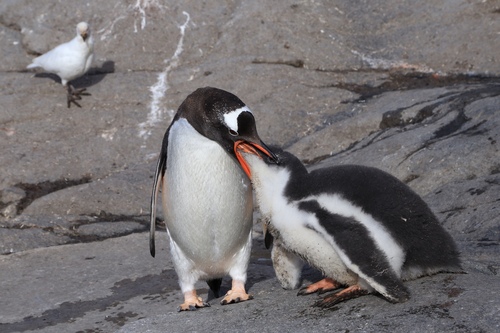
Gentoo Penguin
The Gentoo Penguin (*Pygoscelis papua*) is a charismatic and easily recognizable penguin species, known for its distinctive white stripe extending across the top of its head like a bonnet. Gentoos are the third-largest penguin species, after the Emperor and King Penguins. They play a crucial role in the Antarctic and sub-Antarctic ecosystems as both predator and prey. While not currently considered globally threatened, they face increasing pressures from climate change, fisheries interactions, and habitat disturbance. They have no specific cultural significance, but their image is often used to represent Antarctica.
75-90 cm
Length
N/A cm
Wingspan
Near Threatened
Conservation Status
Distribution
Gentoo Penguins have a circumpolar distribution, breeding on the Antarctic Peninsula and numerous sub-Antarctic islands, including the Falkland Islands, South Georgia, South Sandwich Islands, Kerguelen Islands, and Macquarie Island. They generally remain close to their breeding colonies year-round, although some populations may disperse further in the non-breeding season.
Lifespan
Typically 10-15 years in the wild, but can exceed 20 years.
Gentoo Penguin's Habitat
Habitat Types
Ice-free coastal areas, Rocky shorelines, Low-lying grasslands, Tussock grass areas
Climate Zones
Sub-Antarctic, Antarctic
Adaptations
Gentoo Penguins are highly adapted to cold, marine environments. They have dense, waterproof plumage, a thick layer of subcutaneous fat for insulation, and countercurrent heat exchange systems in their flippers and legs to minimize heat loss. Their streamlined bodies and powerful flippers make them efficient swimmers.
Variations
Two subspecies are generally recognized: *Pygoscelis papua papua* (northern populations) and *Pygoscelis papua ellsworthi* (southern populations). These subspecies differ slightly in size and morphology.
Appearance
Breeding Plumage
Adult plumage is consistent year-round. Juveniles have a duller plumage, with a less distinct white head stripe and a grayish rather than black back.
Seasonal Feather Changes
No significant seasonal variations in adult plumage. Moulting occurs annually after breeding.
Sex Based Plumage Differences
Minimal sexual dimorphism in plumage. Males and females are visually very similar.
Notable Features
White 'bonnet' stripe across the top of the head, Bright orange-red bill, White eye patches, Long, brush-like tail (relatively long for a penguin)
Diet and Feeding
Primary Foods
Crustaceans (primarily krill), Fish, Squid
Foraging Behavior
Gentoo Penguins are pursuit divers, typically foraging close to shore in relatively shallow waters. They can dive to depths of up to 200 meters, but most dives are shallower. They often forage in groups.
Specializations
Their streamlined bodies and powerful flippers allow for efficient underwater pursuit of prey. Their eyes are adapted for underwater vision.
Seasonal Diet Variations
Diet composition can vary depending on prey availability. During the breeding season, they may rely more heavily on krill, while in other periods, fish and squid may be more important.
Behavior
Social Structure
Gentoo Penguins are highly social, breeding in large colonies that can number in the thousands of pairs. Outside of the breeding season, they may form smaller groups.
Communication
Loud, braying calls (used for mate recognition and territorial defense), Visual displays (bowing, head-swinging, flipper-waving), Mutual preening
Migration
Generally non-migratory, remaining relatively close to their breeding colonies year-round. However, some populations, particularly those in the more southerly regions, may disperse further from the colonies during the non-breeding season in search of food.
Territorial or Group Behaviors
Gentoos are territorial during the breeding season, defending their nest site from intruders. They often engage in aggressive displays, including pecking and flipper-slapping.
Conservation
Threats
Climate change (affecting sea ice extent and prey availability), Fisheries interactions (competition for prey and accidental bycatch), Habitat disturbance (tourism, human settlements), Pollution (oil spills, plastic debris), Predation (by introduced species on some islands)
Protection Programs
Antarctic Treaty System (provides general protection for the Antarctic environment), Commission for the Conservation of Antarctic Marine Living Resources (CCAMLR) (manages fisheries in the Southern Ocean), Marine Protected Areas (MPAs) (protecting key foraging and breeding areas), Monitoring programs (tracking population trends and breeding success)
Local National Laws
Various national laws protect Gentoo Penguins and their habitats within the jurisdictions of countries with breeding colonies (e.g., Falkland Islands, South Georgia, Argentina, Chile, Australia).
Population Trend
Decreasing
Population Estimates
Approximately 774,000 mature individuals.
Interesting Facts
Gentoos are the fastest underwater swimming penguins.
They can reach speeds of up to 36 kilometers per hour (22 mph) when pursuing prey.
Gentoo Penguins often build their nests with stones.
Males will compete for the best stones and present them to females as part of courtship rituals. Stone stealing from neighboring nests is common.
The name 'Gentoo' is of uncertain origin.
It may have originated from a term used by early explorers to refer to inhabitants of India, and was possibly applied to the penguins due to the white patch on their heads resembling a turban.
Gentoo Penguins can hold their breath for up to 7 minutes.
Although the ususal dive time is between 1 and 2 minutes.
Gentoo Penguins are very curious
They are curious birds and are known to approach humans.
Faqs about Gentoo Penguin
What do Gentoo Penguins eat?
Gentoo Penguins primarily eat crustaceans (like krill), fish, and squid. Their diet can vary depending on the season and location.
Where do Gentoo Penguins live?
Gentoo Penguins live in the Antarctic Peninsula and on sub-Antarctic islands, such as the Falkland Islands, South Georgia, and Kerguelen Islands.
Are Gentoo Penguins endangered?
Gentoo Penguins are currently classified as Near Threatened by the IUCN. While some populations are stable or increasing, others are declining due to threats like climate change and fisheries interactions.
How deep can Gentoo Penguins dive?
Gentoo Penguins can dive up to 200 meters (656 feet), but they usually forage in shallower waters.
How many eggs does a Gentoo Penguin lay?
Usually 2 eggs.
Copyright @ Nature Style Limited. All Rights Reserved.
 English
English